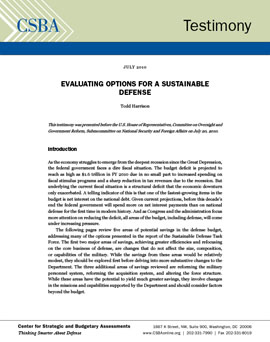
As the economy struggles to emerge from the deepest recession since the Great Depression, the federal government faces a dire fiscal situation. The budget deficit is projected to reach as high as $1.6 trillion in FY 2010 due in no small part to increased spending on fiscal stimulus programs and a sharp reduction in tax revenues due to the recession. But underlying the current fiscal situation is a structural deficit that the economic downturn only exacerbated. A telling indicator of this is that one of the fastest-growing items in the budget is net interest on the national debt. Given current projections, before this decade’s end the federal government will spend more on net interest payments than on national defense for the first time in modern history. And as Congress and the administration focus more attention on reducing the deficit,all areas of the budget, including defense, will come under increasing pressure.
The following pages review five areas of potential savings in the defense budget, addressing many of the options presented in the report of the Sustainable Defense Task Force. The first two major areas of savings, achieving greater efficiencies and refocusing on the core business of defense, are changes that do not affect the size, composition, or capabilities of the military. While the savings from these areas would be relatively modest, they should be explored first before delving into more substantive changes to the Department. The three additional areas of savings reviewed are reforming the military personnel system, reforming the acquisition system, and altering the force structure. While these areas have the potential to yield much greater savings, they involve changes in the missions and capabilities supported by the Department and should consider factors beyond the budget.

























